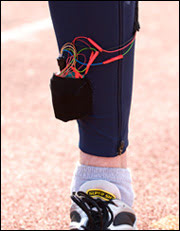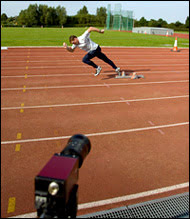
Sensor of Champions
LONDON, Sept. 13, 2007 -- A sensor that collects and immediately transmits data from the human body could boost athletes' performance and eventually contribute to health care.
About the size of some cufflinks, the sensor is clipped behind a wearer's ear and is reportedly inobstrusive yet can gather an unprecedented variety of data about posture, stride length, step frequency, acceleration and response to shock waves traveling through the body and other data. It can transmit the information for immediate visual display on a handheld device or laptop to, for example, a track coach. The coach can use the data to provide feedback on the athlete's technique. By instantly adding to the value of a training session, the sensor can result in better athletic performance, said its creators.

Data collected by the new sensor will translate directly into improved athletics performance, its creators said. (Photo courtesy Julien Fauqueur)
The device is under development at Imperial College London, with funding from the Engineering and Physical Sciences Research Council (EPSRC) and the UK government’s Technology Programme. Its potential contribution to athletics and health care will be at topic at the BA (British Association for the Advancement of Science) Festival of Science 2007, being held this week at the University of York and sponsored by the university and the city of York.
“The sensor we’re working on is inspired by the semicircular canals of the inner ear, which play a key role in controlling our motion and balance,” said Guang Zhong Yang, a professor and director of medical imaging in the computing department at Imperial College, who is leading the project and is delivering the presentation today. Yang is a pioneer in the field of body sensor networks (BSNs); his multidisciplinary project team has diverse expertise, in computer science, electronics, engineering and biomechanics (the study of body movements and the forces acting on the body during activity).

The "on-athlete" sensor package collects data and transmits it wirelessly. (Photo courtesy Julien Fauqueur)
He said the new sensor does not cause discomfort and, because it is worn behind the ear, does not adversely affect aerodynamics. The data it generates therefore provides an authentic and realistic indication of how the wearer’s body would behave if performing without the sensor. This makes the information extremely valuable, he said.
"By contrast, body sensors currently available are cumbersome to wear and so affect technique and performance, making the information they produce less useful," Yang said. "Moreover, their data cannot be displayed in real time, but requires processing before being viewed after the training session. Having biomechanical data available there and then, during a training session, can make the whole process of improving sporting technique much quicker and easier."
He said the sensor could also have significant potential for use in monitoring patients with varioius injuries and illnesses, and even in "helping to preserve good health and to promote quality of life generally," Yang said. "It has scope, for example, to be used to monitor patients with degenerative arthritis or neurological gait abnormalities, as well as those who have undergone orthopaedic surgery."

A high-speed camera automatically tracks an athlete during training. (Photo courtesy Julien Fauqueur)
In the field of human/computer interfacing, the device could also make a unique contribution to translating body movement and physical exercise into computer games and virtual reality-based sports training.
“I believe it’s really important to ensure that sports-related research like ours will have a genuine legacy in wider fields and a positive impact on society at large,” Yang said.
The is now undergoing trials with top UK athletes. It is hoped to see widespread use among athletes in 12 to 18 months, initially for sprinters but eventually for rowers and other athletes, Yang said. The project, "Sports Body Sensor Networks (Sports-BSN)," will last 18 months and will receive nearly £163,000 (about $331,500) in EPSRC funding.
Fore more information, visit: www.epsrc.ac.uk
Published: September 2007